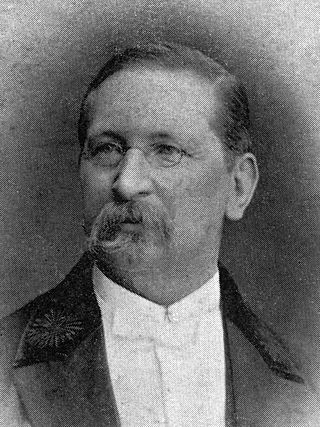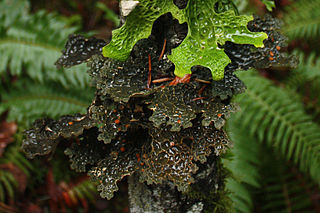
Galinthias is an African genus of praying mantises ; it is the type genus for the new family Galinthiadidae.

Tord Tamerlan Teodor Thorell was a Swedish arachnologist.

Johan August Wahlberg was a Swedish naturalist and explorer. Wahlberg started studying chemistry at the University of Uppsala in 1829, and later forestry, agronomy and natural science, graduating from the Swedish Forestry Institute in 1834. In 1832 he joined Professor Carl Henrik Boheman, a famous entomologist, on a collecting trip to Norway. In 1833 and 1834 he travelled in Sweden and Germany on forestry research projects. He joined the Office of Land Survey and was appointed an engineer in 1836, becoming an instructor at the Swedish Land Survey College.

Frans Reinhold Kjellman was a Swedish botanist who specialized in marine phycology and is known in particular for his work on Arctic algae.

Astape is a genus of praying mantis in the family Haaniidae, containing the single species Astape denticollis.

Abrothallus is a genus of lichenicolous fungi. It is the only genus in the monotypic family Abrothallaceae, which itself is the sole taxon in the order Abrothallales.

Rhizocarpon is a genus of crustose, saxicolous, lecideoid lichens in the family Rhizocarpaceae. The genus is common in arctic-alpine environments, but also occurs throughout temperate, subtropical, and even tropical regions. They are commonly known as map lichens because of the prothallus forming border-like bands between colonies in some species, like the common map lichen.
Malmeomyces is a genus of fungi within the Niessliaceae family. This is a monotypic genus, containing the single species Malmeomyces pulchellusStarbäck.

Pseudocyphellaria is a genus of large, leafy lichens that are sometimes referred to as "specklebelly" lichens. The genus has a widespread distribution, especially in south temperate regions, and contains about 170 species. They resemble Lobaria, except that most species of Pseudocyphellaria have conspicuous pseudocyphellae on their lower surface, a characteristic that was once considered unique to this genus. Some species contain pulvinic acid-related pigments; in these species the soredia and pseudocyphellae can be bright yellow.

Spilostethus is a genus of bugs in the family Lygaeidae. Most species in this genus are from the Palearctic and Oriental regions.
Fulcinia is a genus of praying mantises found in Australia. It is the type genus of the subfamily Fulciniinae and tribe Fulciniini.

Bryum elegans is a species of mosses in the family Bryaceae. It is found in Norway, Poland, and the Russian Federation.

Tropidomantis is a genus of praying mantis in the family Nanomantidae, with species recorded from Asia and the Pacific islands.
Ambivia is a genus of praying mantids in the subfamily Acromantinae and the tribe Acromantini; species distribution records include Indo-China.

Eomantis guttatipennis is a species of praying mantis in the family Nanomantidae. It is the type species of the genus Eomantis, having previously been placed in Tropidomantis. This species has been recorded from India, Nepal, Tibet, Myanmar and Vietnam.
Pseudocyphellaria allanii is a species of corticolous (bark-dwelling) and foliose (leafy) lichen in the family Peltigeraceae. Found in New Zealand, it was formally described as a new species in 1982 by Bernd Renner and David Galloway. The type specimen was collected by Galloway on the path to Emily Falls on Mount Peel ; here it was found growing on a fallen Pseudowintera on a stream bank. The lichen contains the secondary compounds 7β-acetoxyhopan-22-ol and hopan-15α-22-diol, which are derivatives of the triterpene compound hopane. The specific epithet allanii honours New Zealand botanist Harry Allan, who "described the vegetation of Mt Peel, and who later promoted interest in New Zealand lichens".

Pseudocyphellaria glabra is a species of corticolous (bark-dwelling), foliose lichen in the family Peltigeraceae. It has a pale-green upper thallus surface, a white medulla and white pseudocyphellae.
Abrothallus granulatae is a species of lichenicolous fungus in the family Abrothallaceae. Found in South America, it was formally described as a new species in 1994 by Swedish lichenologist Mats Wedin. The type specimen was collected by the author on the eastern shore of Lago Roca in Tierra del Fuego National Park, where it was found on the thallus of the foliose lichen Pseudocyphellaria granulata, which itself was growing on the base of a dead Nothofagus tree. The species epithet of the fungus refers to the epithet of its host lichen. The anamorph form of the fungus was concurrently named Vouauxiomyces granulatae. Characteristics of the fungus include the dense clusters formed by its apothecia, and its 2-septate ascospores. Abrothallus granulatae has also been collected in Chile.
Abrothallus secedens is a species of lichenicolous fungus in the family Abrothallaceae. Found in Africa, South America, and the United States, it was formally described as a new species in 1994 by Swedish lichenologists Mats Wedin and Rolf Santesson. The type specimen was collected by the first author on the Martial Glacier in Ushuaia at an altitude of 550 m (1,800 ft), where it was found on the thallus of the foliose lichen Pseudocyphellaria dubia, which itself was growing on the base of a Nothofagus antarctica tree. It has also been collected in Chile, Kenya, and Alaska. The species epithet of the fungus, secedens refers to the two-celled ascospores that eventually separate into single-celled part spores. Known hosts for Abrothallus secedens include Crocodia aurata, Pseudocyphellaria dubia, P. mallota, P. obvoluta, and other Pseudocyphellaria lichens not identified to species.













